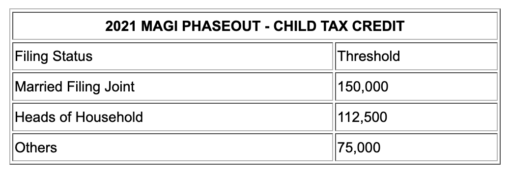Article Highlights:
- American Rescue Plan Act
- 2021 Enhanced Child Tax Credit
- Credit Phaseout
- Advance Payments
- TIGTA Report
- Millions Entitled to But Did Not Receive the Credit
- Credit Still Available to Those That Qualify
The American Rescue Plan Act of 2021, also referred to as the COVID-19 Stimulus Package or ARPA, was a $1.9 trillion bill passed by Congress to stimulate the U.S. economy as the country emerges from the pandemic.
Included in that legislation was a one-year groundbreaking enhancement of the child tax credit for 2021 only. Though it made no changes to the rules about dependency, the law boosted the existing credit from $2,000 to $3,000 for parents of a child aged 6 to 17 (this is a one-year increase from the normal age 16 cutoff).
The credit is intended for lower income families and includes a phaseout that reduces the credit by $50 for each $1,000 (or fraction thereof) by which the taxpayer’s modified gross income exceeds the thresholds illustrated in this table.

Not only did the bill increase the credit, it also required the IRS to provide monthly payments to parents of up to half of the amount of the credit from July through December of 2021, with the balance credited to them when they filed their 2021 tax return.
This is where implementing the credit got complicated for the IRS. They needed to determine, based on prior tax filings, who was entitled to pre-payments. As you might imagine this is where things could go awry, and they did. Many individuals not entitled to the advance payments received them and many who should have received them did not.
A recent report from the Treasury Inspector General for Tax Administration (TIGTA) shows the IRS, between July and November of 2021, made payments to approximately 1.5 million taxpayers who were not entitled to the payments totaling more than $1.1 billion. The report also found that there were 4.1 million eligible taxpayers who did not receive payments totaling nearly $3.7 billion.
If you were entitled to but did not receive advance payments, it may be because your income in prior years was below the filing requirement and the IRS did not have the data needed to determine if you qualified for an advance payment. It may also be the case if you were required to file and simply didn’t do so. You may also be missing out on the credit, which is refundable even if you have no tax liability, if you have not filed for 2021 because your 2021 income is below the filing requirement. Or, you may have had a new child in 2021 and have not filed yet.
This credit is still available. So, whatever the reason, if you think you might qualify and didn’t receive the full amount of the credit by pre-payments or on your 2021 return if you’ve already filed it, give this office a call so your circumstance can be reviewed to make sure you are not leaving a substantial tax refund on the table.




